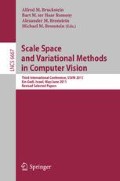Abstract
Similarity and correspondence are two fundamental archetype problems in shape analysis, encountered in numerous application in computer vision and pattern recognition. Many methods for shape similarity and correspondence boil down to the minimum-distortion correspondence problem, in which two shapes are endowed with certain structure, and one attempts to find the matching with smallest structure distortion between them. Defining structures invariant to some class of shape transformations results in an invariant minimum-distortion correspondence or similarity. In this paper, we model shapes using local and global structures, formulate the invariant correspondence problem as binary graph labeling, and show how different choice of structure results in invariance under various classes of deformations.
Access this chapter
Tax calculation will be finalised at checkout
Purchases are for personal use only
Preview
Unable to display preview. Download preview PDF.
References
Berg, A., Berg, T., Malik, J.: Shape matching and object recognition using low distortion correspondences. In: Proc. CVPR, vol. 1 (2005)
Mémoli, F., Sapiro, G.: A theoretical and computational framework for isometry invariant recognition of point cloud data. Foundations of Computational Mathematics 5, 313–346 (2005)
Bronstein, A.M., Bronstein, M.M., Kimmel, R.: Generalized multidimensional scaling: a framework for isometry-invariant partial surface matching. PNAS 103, 1168–1172 (2006)
Bronstein, A.M., Bronstein, M.M., Kimmel, R.: Calculus of non-rigid surfaces for geometry and texture manipulation. Trans. Visualization and Computer Graphics 13, 902–913 (2007)
Sun, J., Ovsjanikov, M., Guibas, L.J.: A concise and provably informative multi-scale signature based on heat diffusion. Computer Graphics Forum 28, 1383–1392 (2009)
Ovsjanikov, M., Bronstein, A.M., Bronstein, M.M., Guibas, L.J.: Shape Google: a computer vision approach to invariant shape retrieval. In: Proc. NORDIA (2009)
Bronstein, M.M., Kokkinos, I.: Scale-invariant heat kernel signatures for shape recognition. INRIA Technical Report 7161 (2009)
Zaharescu, A., Boyer, E., Varanasi, K., Horaud, R.: Surface Feature Detection and Description with Applications to Mesh Matching. In: Proc. CVPR (2009)
Thorstensen, N., Keriven, R.: Non-rigid Shape matching using Geometry and Photometry. In: Proc. CVPR (2009)
Rustamov, R.M.: Laplace-Beltrami eigenfunctions for deformation invariant shape representation. In: Proc. SGP, pp. 225–233 (2007)
Mateus, D., Horaud, R.P., Knossow, D., Cuzzolin, F., Boyer, E.: Articulated shape matching using laplacian eigenfunctions and unsupervised point registration. In: Proc. CVPR (2008)
Hu, J., Hua, J.: Salient spectral geometric features for shape matching and retrieval. Visual Computer 25, 667–675 (2009)
Dubrovina, A., Kimmel, R.: Matching shapes by eigendecomposition of the Laplace-Beltrami operator. In: Proc. 3DPVT (2010)
Lipman, Y., Funkhouser, T.: Möbius voting for surface correspondence. TOG 28 (2009)
Zeng, Y., Wang, C., Wang, Y., Gu, X., Samaras, D., Paragios, N.: Dense non-rigid surface registration using high-order graph matching. In: Proc. CVPR (2010)
Elad, A., Kimmel, R.: Bending invariant representations for surfaces. In: Proc. Computer Vision and Pattern Recognition (CVPR), pp. 168–174 (2001)
Bronstein, A.M., Bronstein, M.M., Kimmel, R., Mahmoudi, M., Sapiro, G.: A Gromov-Hausdorff framework with diffusion geometry for topologically-robust non-rigid shape matching. IJCV, 1–21 (2010)
Qiu, H., Hancock, E.R.: Clustering and embedding using commute times. Trans. PAMI 29, 1873–1890 (2007)
Gromov, M.: Structures Métriques Pour les Variétés Riemanniennes. Textes Mathématiques (1) (1981)
Torresani, L., Kolmogorov, V., Rother, C.: Feature correspondence via graph matching: Models and global optimization. In: Forsyth, D., Torr, P., Zisserman, A. (eds.) ECCV 2008, Part II. LNCS, vol. 5303, pp. 596–609. Springer, Heidelberg (2008)
Bertsekas, D.P.: Nonlinear Programming. Athena Scientific (1999)
Komodakis, N., Paragios, N., Tziritas, G.: MRF optimization via dual decomposition: Message-passing revisited. In: Proc. ICCV (2007)
Zhang, H., Sheffer, A., Cohen-Or, D., Zhou, Q., van Kaick, O., Tagliasacchi, A.: Deformation-driven shape correspondence. Computer Graphics Forum 27, 1431–1439 (2008)
Raviv, D., Bronstein, A., Bronstein, M., Kimmel, R.: Symmetries of non-rigid shapes. In: Proc. NRTL (2007)
Memoli, F. On the use of gromov-hausdorff distances for shape comparison
Ovsjanikov, M., Sun, J., Guibas, L.J.: Global intrinsic symmetries of shapes. Computer Graphics Forum 27, 1341–1348 (2008)
Coifman, R.R., Lafon, S., Lee, A.B., Maggioni, M., Nadler, B., Warner, F., Zucker, S.W.: Geometric diffusions as a tool for harmonic analysis and structure definition of data: Diffusion maps. PNAS 102, 7426–7431 (2005)
Grinstead, C.M., Snell, L.J.: Introduction to Probability. AMS (1998)
Gold, S., Rangarajan, A.: A graduated assignment algorithm for graph matching. Trans. PAMI 18, 377–388 (1996)
Hochbaum, D., Shmoys, D.: A best possible heuristic for the k-center problem. Mathematics of Operations Research 10(2), 180–184 (1985)
Bronstein, A.M., Bronstein, M.M., Kimmel, R.: Numerical geometry of non-rigid shapes. Springer, Heidelberg (2008)
Shilane, P., Min, P., Kazhdan, M., Funkhouser, T.: The Princeton shape benchmark. In: Proc. SMI, pp. 167–178 (2004)
Kimmel, R., Sethian, J.A.: Computing geodesic paths on manifolds. PNAS 95, 8431–8435 (1998)
Meyer, M., Desbrun, M., Schroder, P., Barr, A.H.: Discrete differential-geometry operators for triangulated 2-manifolds. Visualization and Mathematics III, 35–57 (2003)
Author information
Authors and Affiliations
Editor information
Editors and Affiliations
Rights and permissions
Copyright information
© 2012 Springer-Verlag Berlin Heidelberg
About this paper
Cite this paper
Wang, C., Bronstein, M.M., Bronstein, A.M., Paragios, N. (2012). Discrete Minimum Distortion Correspondence Problems for Non-rigid Shape Matching. In: Bruckstein, A.M., ter Haar Romeny, B.M., Bronstein, A.M., Bronstein, M.M. (eds) Scale Space and Variational Methods in Computer Vision. SSVM 2011. Lecture Notes in Computer Science, vol 6667. Springer, Berlin, Heidelberg. https://doi.org/10.1007/978-3-642-24785-9_49
Download citation
DOI: https://doi.org/10.1007/978-3-642-24785-9_49
Publisher Name: Springer, Berlin, Heidelberg
Print ISBN: 978-3-642-24784-2
Online ISBN: 978-3-642-24785-9
eBook Packages: Computer ScienceComputer Science (R0)

